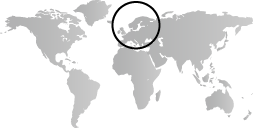The peoples of eastern Europe and Scandinavia gradually developed agriculture and pottery, the two technologies that define Neolithic culture elsewhere. Although these developments are conventionally linked with the growth of settled village life, the inhabitants of Scandinavia and eastern Europe seem to have retained seasonal dwellings and a hunter’s way of life even after they became successful part-time farmers.
Eastern Europe and Scandinavia, 8000–2000 B.C.
Timeline
8000 B.C.
6500 B.C.
NORTHERN
SOUTHERN
6500 B.C.
5000 B.C.
NORTHERN
SOUTHERN
5000 B.C.
3500 B.C.
NORTHERN
SOUTHERN
3500 B.C.
2000 B.C.
NORTHERN
SOUTHERN
Overview
Key Events
-
ca. 7500 B.C.
The manufacture of microliths, small and carefully shaped stone elements of larger tools, becomes widespread in Scandinavia. Close analysis of the various types has enabled archaeologists to distinguish three successive Mesolithic cultures: the Maglemosian, the Konglemosian, and the Ertebølle.
-
ca. 4500 B.C.
The Cucuteni-Tripolyte culture of Romania and the southern Ukraine flourishes. The two archaeological sites for which the culture is named have yielded evidence of copper technology and a distinctive pottery painted with vigorous wavelike patterns in black and white.
-
ca. 4000 B.C.
Rock faces in Norway are carved with animal subjects, especially elk, often with internal organs and skeletons visible within naturalistically drawn bodies. The depictions may mark places along the animals’ migration routes, or they may relate to shamanism.
-
ca. 3600 B.C.
The Ertebølle culture of Scandinavia produces pottery, including pointed-bottomed pots and oval bowls. An expanding range of shapes suggests diversification of diet, cuisine, and manners. Ertebølle settlements have yielded baskets and fish traps made of complex wickerwork. Yarns made from plant fibers and wooden paddles decorated with impressed geometric patterns have been found at Tybrind Vig, a coastal site in Denmark.
-
ca. 3500–2500 B.C.
Communities in Scandinavia build passage tombs and dolmens of megaliths, undressed stone blocks weighing up to forty tons. Although simple in design, the monuments are evidence of well-organized endeavor that must have involved many workers in lifting and transporting the stones.
-
ca. 2800 B.C.
Corded ware, a hand-formed pottery decorated with simple designs made by pressing twine into its surface, appears around the Baltic. Like other Neolithic peoples, the makers of this ware are probably farmers living in year-round settlements. They may be newcomers in the Baltic region, where pottery and agriculture are already known but settled communities not yet the norm.
-
ca. 2500–2000 B.C.
Artisans in Denmark create beautiful flint objects by laboriously chipping and polishing the stone, revealing its multicolored brilliance. Because these flints lack holes for mounting on a shaft, it is unknown whether they had a functional purpose or were kept as prestige objects.
-
ca. 2200–1600 B.C.
Kurgans, or burial mounds, distinguish the Late Neolithic culture of the Baltic and steppe. Important members of the community are buried in the ground with grave goods, and earth is heaped on top to create a mound. The custom may indicate a greater emphasis on elite households and the individual as opposed to collective commemoration of ancestors claimed by a whole community.
Citation
“Eastern Europe and Scandinavia, 8000–2000 B.C.” In Heilbrunn Timeline of Art History. New York: The Metropolitan Museum of Art, 2000–. http://www.metmuseum.org/toah/ht/?period=02®ion=eue (October 2000)
